Resources
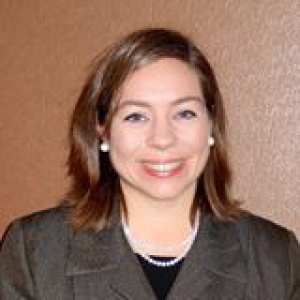
There are at least two uses of the phrase “good enough.” One meaning commonly found in public discourse denotes minimal, less than best effort. The other meaning, a more technical one from psychology, requires a focused discipline of self-awareness that guards against unhealthy perfectionism (“I can and I will be perfect”) or academic narcissism (“I can and I will know it all”). I often hear the more negative meaning in theological education: “I don’t want my students to be good enough,” a colleague said to me after reading my recent blog,[1] “I want them to be better than good enough.” After seeing the course learning goal to “define and give examples of good enough pastoral care,” a student remembered a motivational saying from their childhood that ran “good enough is the enemy of excellence.” These are important concerns if good enough means minimal, irresponsible engagement. However, taken as a discipline of ongoing rigorous self-awareness, good enough teaching and learning is an important part of pedagogical excellence. I believe teaching and learning must be good enough, in this sense, to support thriving.[2] Good enough teaching and learning involves identifying and responding to the predictable misconnections in our craft so that thriving is an available possibility for all teachers and learners. A Mishap in Connecting the Dots I recently made a teaching mistake involving extreme connect-the-dots. While I was familiar with the burgeoning market of adult mindfulness coloring books, a colleague introduced me to “extreme connect-the-dots” at a theory-heavy small academic meeting. The meeting involved wonderful academic papers and a lot of sitting and listening, and the exercise provided a strategy for mindful focusing. I was surprised that connecting the tiny numbered dots from one-to-seven-hundred-and-something to make my own dot-to-dot “Mona Lisa” did help me focus. Later, I decided to try this in my classroom in a week-long intensive course that met from 8:30 am-5:00 pm for five days straight. I am always up for new strategies for focus and energy in such a setting! In addition to trustworthy strategies like varying course activities and scheduling mid-week field work, I purchased an extreme connect-the-dot book called something like “florals and other calming themes.” I tried out a few and then distributed some pages I had not yet completed myself. This turned out to be a mistake. During the mid-morning break the first day, a student came up and said that I might want to take a look at how she had connected the dots. To my surprise, once the dots were connected, one “floral and other calming theme” image depicted a human being in troubling cultural stereotype. Embarrassed, I ended that connect-the-dot opportunity and replaced it with coloring sheets. After processing the mishap with my student, I decided not to use class time to address the event since other students had not worked on the images. In hindsight, not disclosing what had happened to other students was likely a missed teaching and learning moment that could have benefitted the class. While not perfect, the class went well, overall. An Overall, Good Enough Class Overcoming the felt need for pedagogical perfection is a constant struggle. I am increasingly wary of the word “perfect” in my home or classroom. When my son was in preschool, one day he said, “my day was good, overall.” Struck by his use of the word “overall,” I asked what he meant. He said that anyone can make three mess ups and have an overall good day. He proceeded to tell me about his mess ups that day—not listening, not paying attention to his body in space, hurting someone’s feelings. He explained that tomorrow you can do better if you work on these mess ups today. As a pastoral theologian invested in good enough teaching and learning, I find the idea of an overall good enough day to be a helpful assessment tool. I hope to train and learn with budding theologians whose excellence includes (1) being aware that they will inevitably make mistakes and (2) practicing the courage needed to address and learn from mess ups in order to (3) be ever mindful of confessing and minimizing harm in the world. A good enough learning environment is not perfect, but rather thoughtful and open to continued learning. One way to connect the dots before class, metaphorically, is to think about the students and teachers who do not have the luxury of making mistakes, not even one minor mess up in a day not to mention three. Absurd Expectations Academic pressures around perfectionism often have complex aspects. Immigration, poverty, identity politics, the school to prison pipeline, and uneven preparation for graduate education from preschool to PhD contribute additional stress for some students who have to fight for a place at a table that likely was designed without “them” in mind. These same systemic pressures force some students and teachers to have to be perfect in unhealthy ways – no learning curve, no grace in student evaluations, no wiggle room for mistakes. If only we could connect the dots ahead of time, theological educators could better support colleagues and students who live and learn with such heightened anxiety. “Would you rather imagine me be in prison or in school,” asked a DACA recipient who was talking with my class about the fragility of his citizenship status that pressures him to excel in all areas as a student. With a high school GPA above 4.0, multiple leadership experiences in school and extracurricular activities, and a model resume already at a young age, he recognizes the absurd expectations placed on him to be able to have a chance at keeping his family together. “Imagine,” writes bell hooks, “what it is like to be taught by a teacher who does not believe you are fully human [and therefore] really believes [you] are incapable of learning.”[3] It’s not hard for my DACA recipient friend and teacher to imagine. With my citizenship and other privileges, I commit to stretch my imagination to connect the dots so that no one is dehumanized in my classes, so that everyone has a chance to be good enough, to have overall good days, to thrive in their dreams. And yet the learning around that must be on-going rather than a static perfection. Dreaming of an Open Invitation to Good Enough Learning Days I’ve been imagining what it would look like to treat my syllabus, booklists, classroom space arrangements, and use of time, assignments, and discussions as working together to open a pathway for belonging when absurd expectations exclude some students from thriving. What does it feel like when everything is instead working well in a learning environment? For me, on the best good enough learning days (1) I feel prepared enough, (2) students arrive prepared and energetic enough, (3) there is enough of a sense that the subject at hand matters deeply, (4) multiple voices and perspectives are voiced and heard, (5) students and I hear new connections and disconnections verbalized in the learning encounter, (6) unanticipated new insights and questions deepen conversation, (7) we are all still thinking about the class beyond the constraints of our time together in a classroom or online, and (8) something from the class may spill over into coffee conversations, office hours, semester assignments, even program assessment. On your best good enough learning days, what would you add? Indeed, such a day would really be a good enough learning day! I conclude these reflections with some open questions for theological educators teaching religion in a politically challenging time. Are really good days available to all of the students in my class or the colleagues in my school? How about in your context? On each account, what are the avenues of participation for students and faculty? What are the roadblocks? What collaborations, accountabilities, self-reflection habits, and continuing education will help me connect as many dots as possible in advance of the class? How will I identify and respond to predictable misconnections in real time? How can theological educators work strategically in our own classrooms and across institutions to support dreamers’ thriving? [1] This blog follows from a previous blog entitled “The Privilege of Good Enough? Challenges of Radical Hospitality in Theological Education,” published November 9, 2017, at https://www.wabashcenter.wabash.edu/2017/11/privilege-good-enough-challenges-radical-hospitality-theological-education/ [2] I have in mind supporting the thriving dreams of all who embark in teaching and learning in hopes of honing critical tools and collaborative practices to address a suffering world yearning for new ideas and strategies of transformation. I also have in mind Dreamers as the group of students who seek support for more humane immigration reform. I dedicate this blog to the tenacity of the Dreamers who teach me to work for systems that allow good enough teaching and learning to be available to all. For further information in this historical moment, download a toolkit to support Dreamers here: http://www.scholarshipsaz.org/students/educators/. [3] bell hooks, Teaching critical thinking. New York, NY: Routledge, 2010, p. 2.

Every time I walk into a classroom or workshop for the first time, I hear the voices of elders in the long, Black-led struggle for justice pressing the questions: “How are you going to bring people into the movement? How are you going to plant the seeds and bring forth a revolution of values?” My thoughts are always about what it means to model the just peace of the society that is and has yet to be. The orientation I bring to the classroom or workshop space is one of religion and nonviolent social change focused in civic engagement and social action. The tasks and challenges we face today in the religious studies and peace studies classrooms are not unlike those faced over the past several decades. Rev. Dr. Martin Luther King, Jr. gave his “Breaking the Silence: Beyond Vietnam” sermon 50 years ago. In the sermon King called us to a “revolution of values.”[1] The revolution of values is a move away from a thing-oriented society toward a human-oriented society. It helps to create a society where everyone has their needs met and no one is oppressed. King was speaking out against the value the United States placed on the evils of racism, materialism, and militarism. According to elder Grace Lee Boggs, a revolution of values and building up the Beloved Community, are "about redefining our relationships with one another, to the Earth and to the world; about creating a new society in the places and spaces left vacant by the disintegration of the old; about hope, not despair; about saying yes to life and no to war; about finding the courage to love and care for the peoples of the world as we love and care for our own families.”[2] The recent wave of political and social violence against Black and Brown people, women, queer, non-gender conforming people, and religious minorities is not new. It is just more overt. The risks of talking about religion, politics, and the politics of religion in the classroom are high. We see friends and colleagues being labeled “dangerous.” Yet, our tasks as teachers are to critique and improve society. We do the emotional and complicated work of instilling in our students' religious literacy, a political consciousness, and a sense of calling. A large part of moving students to political consciousness and calling is the idea that human beings are all connected to one another, to the past, to the ancestors, and to the future. In other words, becoming politically conscious is to move toward the understanding that who I am is related to who you are. Simultaneously, the move toward calling presses the idea that what I do is related to social responsibility. Ultimately, what I believe about and how I live has consequences for others. In my courses, religious literacy becomes a tool for moving students into a new political consciousness. Students learn about the beliefs and practices of a variety of religious traditions and the political implications of those traditions. Along the way, students are given the opportunity to reflect on their own beliefs and practices. The pedagogical tools I have found useful in the endeavor to create a revolution of values and a new political consciousness are: Be authentic and present. I try to think of my teaching in terms of a pedagogy of relationship and community. I spend time during the first weeks of a semester allowing students to get to know one another. I treat classroom spaces as community spaces. As the professor, this means being vulnerable and transparent. Students know when a teacher is not being real. I cannot ask students to share their personal stories and experiences without being willing to do so as is appropriate. Make it real. I ask students to reflect on why religious literacy and political consciousness are helpful in their work, their relationships, their vocation, and in their civic engagement. If students can make the material relevant to themselves they are more likely to take it with seriousness. Making it real means exposing students to practitioners and the stories of real people. Teachers having their limits and being transparent about those limits allows students to see do likewise. Be clear about the end goal. If the point is to move students toward a revolution of values, then we must develop a pedagogy of transformation and hope. Too often religious and political discourse is about what we are against. In the words of elder Vincent Harding, “No matter what form education may take . . . I am convinced that one of its most important responsibilities is to nurture the realization that we can change our lives for the better, that another creative, more democratic way of life is possible, that the seeds of such a new way are already alive within us, needing to be nurtured.”[3] In these times the stakes are very high. How are we bringing people into the movement? How are we planning the seeds for a revolution of values? What are working toward? [1] King, Jr., Martin Luther, “Beyond Vietnam,” Available online at https://kinginstitute.stanford.edu/king-papers/documents/beyond-vietnam. Accessed March 8, 2016. [2] Boggs, Grace Lee. “The Beloved Community of Martin Luther King.” May 20, 2004. Yes. http://www.yesmagazine.org/issues/a-conspiracy-of-hope/the-beloved-community-of-martin-luther-king. Accessed August 14, 2014. [3] Harding, Vincent, and Daisaku Ikeda. America Will Be!: Conversations on Hope, Freedom, and Democracy. 2013, 174.
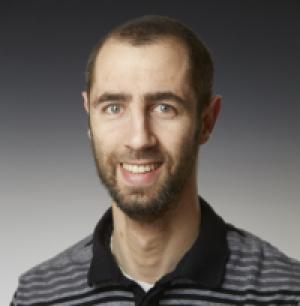
Laughter is an important ingredient in my classroom. I bank on my ability to make students laugh with my often-droll sense of humor, but I also frequently rely on professional comedians through the magic of the Internet. The status of Islam and Muslims in political satire, specifically in the genre of comedy news, provides ample fodder for this need, through projects like The Onion, The Daily Show, The Colbert Report, and Full Frontal (and as much as I cherish Last Week Tonight, John Oliver rarely explores the topic of religion). Indeed, humor also has a long tradition in Islamicate history as well—ranging from the likes of Joha/Nasreddin Hodja to Azhar Usman—but in this blog post, I want to focus on the portrayal of Islam and Muslims in Western satire, sometimes called “fake news.” For better or for worse (often for worse), moreover, the appetite for fake news stories (which at times genuinely fool people!) may also be on the rise. Although this trend can have dire consequences, it renders the genre all the more fertile for generating understanding in the classroom. Lots of learning takes place through the slow, careful, and sometimes tedious (even boring) study of details, but cathartic moments can have a uniquely lasting impact on students. I often seize the moment to employ humor in the classroom not only as a way to keep students interested, but also as a means of transformation. Indeed, things are often funny because they are subversive, because they surprise us—kind of like being tickled. It doesn’t work so well to tickle yourself; because you expect it, there’s no surprise. This element of surprise works particularly well, I find, when combined and contrasted with more traditional modes of pedagogy, such as textual analysis, historical inquiry, and site visits. Accordingly, I select short video clips that I use in class bearing in mind what questions they may generate about a given issue. Some of my favorite examples follow: One of the few Last Week Tonight segments that deals with Islam focuses on a Supreme Court case about the permissibility of inmates growing beards in federal prisons. The clip portrays the Supreme Court Justices as talking animals, as a way to self-consciously heighten interest in the Supreme Court—which not only induces at least a few chuckles, but also offers a meaningful opportunity to discuss First Amendment issues in the context of American religion. Why oh why don’t the “moderate” and “peaceful” Muslims speak up? This clip from Full Frontal with Samantha Bee explores this question as well as myths that Muslims don’t cooperate with law enforcement, or that they hate the United States. The Daily Show’s “Senior Muslim Correspondent,” Hasan Minhaj, has a smart bit about Southwest Airlines’ removal of a Muslim passenger for allegedly speaking Arabic. That Minhaj himself is a brown Muslim speaks to the rhetorical role of his character as well, and he offers a semi-comical but mostly sober reaction to Trump’s election victory. This segment raises an important chicken or the egg question about the nature of political satire: do political motivations inform comedy news or is comedy a way to express political messages? Regarding hysteria over Muslims conspiratorially taking over the United States with their “shari‘a law,” this clip from The Daily Show about mosques and this clip from The Colbert Report about “radical Muslim snacks” (i.e., halal food) have proven successful and provocative in the classroom, by effectively positioning the level of public paranoia in relation to what kinds of practices Muslims actually promote. Clips like these allow me to ask a real but also rhetorical question to my students (who are formally studying Islam): would any of you feel pretty comfortable and informed about defining “shari‘a” on a national news program in front of millions of viewers (who haven’t formally studied Islam)? (Routinely, no one volunteers.) Where do you think the “real news” anchors get their information about this stuff? They probably Google it, I suggest, as food for thought. And people always interpret Google results with wisdom and measure, right? Is Obama a Muslim? No, he’s not. And never was. He even jokes about this, for example, during his remarks at the White House Correspondence Dinner. One of my all-star comedy news clips to use in class comes from the archives of The Colbert Report. It focuses on the aftermath of the 2011 massacre committed by Norwegian Anders Breivik, whom many media outlets quickly identified as a Middle Eastern Muslim, despite coherent evidence. To quote Colbert, “Just because the confessed murderer is a blonde, blue-eyed, Norwegian-born, anti-Muslim Crusader…does not mean he’s not a swarthy ululating Middle Eastern madman.” I find this clip particularly effective as a teaching tool because it not only highlights the absurdity of how sensation-driven journalists reacted to the event, with flamboyantly transparent anti-Muslim bias, but it also pushes the envelope past what the viewer might expect, by presenting a sequence of awkwardly cathartic punch lines. On the unmeasured way in which mainstream media covers religion and violence, this segment on “decoy Muslims” from “The Onion News Network” pushes the envelope by suggesting baby Muslims should be murdered for fear of their possible ties to terrorist attacks. In my experience as a teacher, this kind of humor, which rides the line between grotesque offense and revealing reflection of popular perceptions, can open doors for frank dialogue about complex issues that even engaged students may otherwise find unapproachable because of political sensitivity. Finally, as a spoof on TSA terrorism prevention, this Key & Peele skit offers an ridiculous but lucid critique of airport theater in which a bunch of would-be “Muslim terrorists” in a cave plot to deceive security officials but find themselves stymied by restricting themselves to a 3.4-ounce bottle of toothpaste, as opposed to the 3.5-ounce bottle on which they modeled their attack. Importantly, this flagrantly flippant skit doesn’t downplay the important of national security, but rather invites inquiry: How might the nation achieve this security? Where does one draw the line between personal liberty and public safety? What about non-Muslim terrorists? In conclusion, I have always found humor an effective pedagogical tool in the classroom. And as the onslaught of violently misleading media attention to Islam and Muslims, consumed by our neighbors and students alike, appears to be speeding up, I think the right combination of satire, subversion, and laughing out loud can provide a uniquely powerful classroom presence and learning experience. What are your favorite comedy news clips? Please share them in the comments section below.
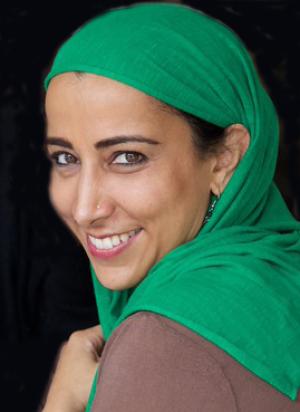
Najeeba Syeed-Miller Assistant Professor Claremont School of Theology I write in a time when the study of Islam is of paramount importance. This blog entry focuses on the teaching of Islam in interreligious settings, with an eye toward the notion of pluralism. So often, engaging this tradition starts with the
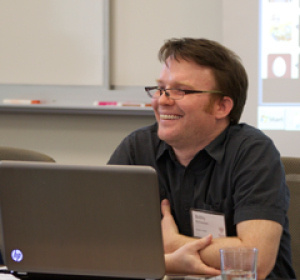
Robert Williamson Jr. is Margaret Berry Hutton Odyssey Assistant Professor of Religious Studies at Hendrix College in Conway, AR The previous post identified three possibilities for using Twitter in class. It is only fair that I also explore three pitfalls...
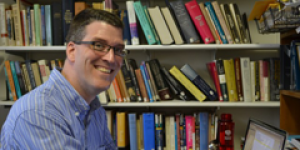
G. Brooke Lester, Assistant Professor of Hebrew Scriptures, and Director for Emerging Pedagogies, Garrett-Evangelical Theological Seminary. Time was, my Biblical Hebrew students and I sweated grimly in a thrice-weekly race against time. But now, with the lectures recorded (as voice-narrated...
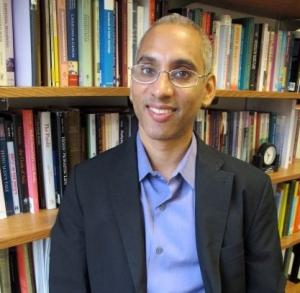
Deepak Sarma, Professor of South Asian religions and philosophy at Case Western Reserve University My unpleasant memories of middle school English classes are made much worse when I recall how some teachers taught poetry and prose by picking “important” passages...